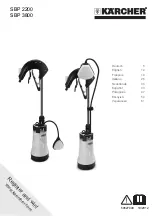
EN-8
English
7.5
7.4.2 Mounting the external temperature
sensor
The temperature sensor must be mounted in such a way that all
weather conditions are taken into consideration and the meas-
ured value is not falsified.
On the external wall of a heated room used as living space,
if possible on the north or north-west side of the building
Do not install in a “sheltered position” (e.g. in a wall niche or
under a balcony)
Not in the vicinity of windows, doors, exhaust air vents, ex-
ternal lighting or heat pumps
Not to be exposed to direct sunlight at any time of year
Sensor lead:
Max. length 40 m; min. core cross-section
0.75 mm²; external diameter of the cable 4-8 mm.
7.4.3 Installing the strap-on sensor
It is only necessary to mount the strap-on sensors if they are in-
cluded in the scope of supply of the heat pump but have not yet
been installed.
The strap-on sensors can be fitted as pipe-mounted sensors or
installed in the immersion sleeve of the compact manifold.
Mounting as a pipe-mounted sensor
Remove paint, rust and scale from heating pipe.
Coat the cleaned surface with heat transfer compound (ap-
ply sparingly).
Attach the sensor with a hose clip (tighten firmly, as loose
sensors can cause malfunctions) and thermally insulate.
7.4.4 Hot water distribution system
The KPV compact manifold and the dual differential pressureless
manifold function as an interface between the heat pump, the
heating distribution system, the buffer tank and, in some cases,
even the hot water cylinder. A compact system is used to simplify
the installation process, so that a lot of different components do
not have to be installed individually. Further information can be
found in the relevant installation instructions.
Compact manifold
The return sensor can remain in the heat pump, or should be in-
stalled in the immersion sleeve. The remaining empty space be-
tween the sensor and the immersion sleeve must be filled com-
pletely with heat transfer compound.
DDV 32 dual differential pressureless manifold
In order for the heating circuit pumps of the generator and con-
sumer circuits to supply the flow to the return sensor, this must
be installed in the immersion sleeve of the dual differential pres-
sureless manifold.
7.5 Electrical connection
7.5.1 General
During start-up, observe the respective national safety regula-
tions and the applicable VDE safety regulations, particularly
VDE 0100, as well as the technical connection requirements of
the utility companies (EVU) and network operators!
To ensure that the frost protection function of the heat pump
works properly, the heat pump manager must remain connected
to the power supply and the flow must be maintained through the
heat pump at all times.
The switching contacts of the output relay are interference-sup-
pressed. Therefore, depending on the internal resistance of the
measuring instrument, a voltage can also be measured when the
contacts are open. However, this will be much lower than the line
voltage.
Extra-low voltage is connected to controller terminals N1-J1 to
N1-J11; N1-J19; N1-J20; N1-J24 and terminal strip X3. If, due to
a wiring error, the line voltage is mistakenly connected to these
terminals, the heat pump manager will be destroyed.
7.5.2 Electrical installation
1)
The supply cable for the output section of the heat pump (up
to 5-core) is fed from the electricity meter of the heat pump
via the utility blocking contactor (if required) into the heat
pump (see heat pump operating instructions for supply volt-
age).
An all-pole disconnecting device with a contact gap of at
least 3 mm (e.g. utility blocking contactor or power contac-
tor) and an all-pole circuit breaker with common tripping for
all external conductors must be installed in the power supply
for the heat pump (tripping current and characteristic in com-
pliance with the device information).
When connecting the device, ensure that the incoming sup-
ply has a clockwise rotating field L1; L2; L3.
ATTENTION!
Ensure that there is a clockwise rotating field: Operating the compressor
in the wrong rotational direction may cause damage to the compressor.
For detailed information, refer to the circuit diagrams in the
appendix.
2)
The three-core supply cable for the heat pump manager
(heating controller N1) is fed into the heat pump.
The control voltage must be protected by a 10 A fuse. The
(L/N/PE~230 V, 50 Hz) supply cable for the heat pump man-
ager must have a constant voltage. For this reason, it should
be tapped upstream from the utility blocking contactor or be
connected to the household current, as important protection
functions may otherwise be lost during a utility block.
3)
The utility blocking contactor (K22) with 3 main contacts (1/
3/5 // 2/4/6) and an auxiliary contact (NO contact 13/14)
should be dimensioned according to the heat pump output
and must be supplied by the customer.
The NO contact of the utility blocking contactor (13/14) is
looped from terminal strip X3/G to connector terminal N1-J5/
D. CAUTION! Extra-low voltage!
4)
The contactor (K20) for the immersion heater (E10) of mono
energy systems (HG2) should be dimensioned according to
the radiator output and must be supplied by the customer. It
is controlled (230 V AC) by the heat pump manager via ter-
minals X2/N and N1-J13/NO4.
+RVHFOLS
6WUDSRQVHQVRU
7KHUPDOLQVXODWLRQ
Содержание LIH 22TE
Страница 2: ......
Страница 26: ...EN 12 English 12 ...
Страница 38: ...FR 12 Français 12 ...
Страница 44: ...A VI Anhang Appendix Annexes 3 2 3 2 Last Load Charge ...
Страница 52: ...A XIV Anhang Appendix Annexes 6 ...
Страница 53: ...www dimplex de A XV Anhang Appendix Annexes 6 ...
Страница 54: ...A XVI Anhang Appendix Annexes 6 ...
Страница 55: ...www dimplex de A XVII Anhang Appendix Annexes 6 ...
















































